
Transmission lines are high-voltage power lines ranging from 69,000 to 345,000 volts that transmit power long distances. OPPD’s transmission system consists of a variety of line sizes and shapes, but trees and other vegetation that grows too close to any of these lines may produce hazardous conditions.
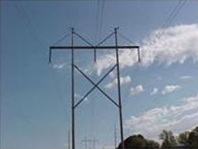
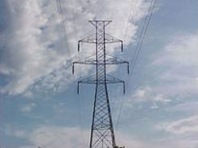
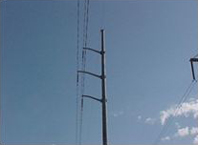
OPPD’s Vegetation Management Program is committed to controlling vegetation growth within transmission line right-of-ways to maintain the safe and reliable operation of the electric transmission system. This program also minimizes adverse impacts on the environment.
Federal, regional and electric industry regulations and standards require minimum safety clearances to ensure vegetation does not come into contact with high-voltage overhead transmission lines.
If vegetation located in a transmission right-of-way is not compatible with the safe operation of the system, it can result in widespread electric power outages and/or unsafe conditions for the public.
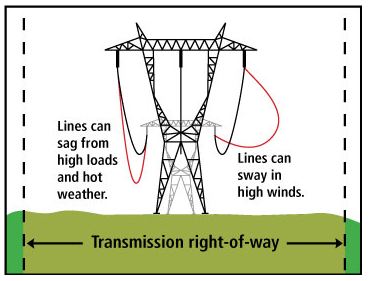 In addition to the following information, here are several frequently asked questions.
In addition to the following information, here are several frequently asked questions.
Transmission Line Sag and Sway
Power lines sag from high electric loads and hot weather. Lines also sway in high winds. OPPD considers both factors when determining if trees need to be trimmed or removed.
Remember to treat all power lines with respect by keeping a safe distance away from them, and report all downed lines to OPPD.
Right-of-Ways and Easements
A right-of-way is a strip of land defined in an easement.
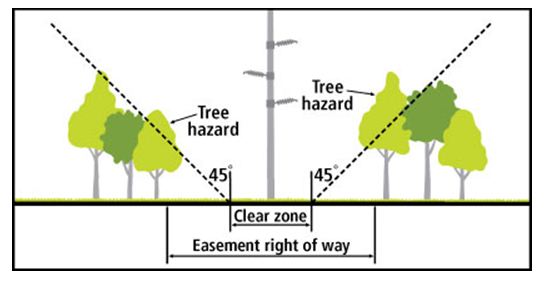
An easement is a right given to an entity (in this case, OPPD) to encroach upon land not owned by the utility in order to access the utility's power lines.
Easement rights allow OPPD to enter the easement area to trim or remove vegetation and to trim trees adjacent to the right-of-way to eliminate danger trees that could potentially fall within 15 feet of power lines.
Right-of-way widths depend mainly on the size of the power line and typically range from 50 to 200 feet.
Vegetation Management Program
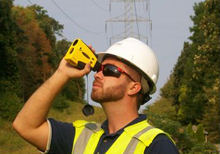 Through this program, OPPD maintains the vegetation on more than 1,200 miles of metropolitan and rural transmission right-of-ways in southeast Nebraska.
Through this program, OPPD maintains the vegetation on more than 1,200 miles of metropolitan and rural transmission right-of-ways in southeast Nebraska.
These maintenance activities are necessary to provide safe and reliable service to all customers within and outside OPPD’s service territory.
Maintenance activities include trimming and removing trees, mowing, applying herbicide, and eliminating hazardous tree/power line conditions.
OPPD inspects transmission lines periodically to determine if vegetation needs mid-cycle trimming due to insufficient power line clearances. These inspections include surveying transmission lines for danger trees and non-compliant tree plantings. If mid-cycle trimming is needed, it is in the best interests of OPPD and its customer-owners to completely remove the tree.
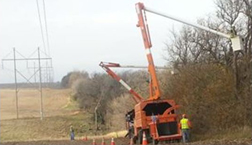
Tree-Trimming
Tree trimming provides for mandatory clearances between power lines and trees. Trees at the edge of the right-of-way are trimmed to eliminate branches growing into the easement space.
Tree-trimming may be done by crews using mechanical trimming equipment or aerial lift trucks, or by climbing crews.
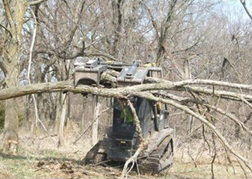 Tree Removal
Tree Removal
Transmission crews remove vegetation that threatens the safe and reliable operation of the electric transmission system.
The main purpose of OPPD's vegetation management program to remove all incompatible trees and shrubs located within the right-of-way. Any tree that poses a potential hazard to the integrity of the transmission line is considered a danger tree and will be removed.
Mowing
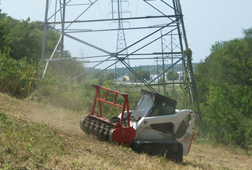 OPPD contractor crews clear vegetation and redefine the easement width with light-duty power equipment. Vegetation near structures, support wires, fences, streams or other difficult-to-access areas may be removed using manual equipment.
OPPD contractor crews clear vegetation and redefine the easement width with light-duty power equipment. Vegetation near structures, support wires, fences, streams or other difficult-to-access areas may be removed using manual equipment.
A combination of mowing and low-volume herbicide applications are used to manage tall growing woody vegetation. This integrated vegetation management approach helps promote and establish a stable, diverse, low-growing plant community on the right-of-way, reducing the potential for soil erosion and is beneficial for wildlife.
Guidelines for Planting in a Transmission Line Right-of-Way

- You must obtain prior approval from an OPPD forester before planting in a transmission line right-of-way. Contact OPPD Forestry.
- No trees or shrubs will be allowed to grow adjacent to line structures and support wires.
- The potential height of a tree or shrub and its planting location will determine whether it is acceptable within the right-of-way.
- Grasses and wildflowers are allowed within the established right-of-way without restriction.
- Please remember that vegetation located within or along the immediate edge of the right-of-way is planted at your own risk. It may be necessary to remove vegetation if it interferes with emergency restoration, line-maintenance or line-construction.
For public safety and grid reliability, it's also important to landscape carefully around padmount transformers.

